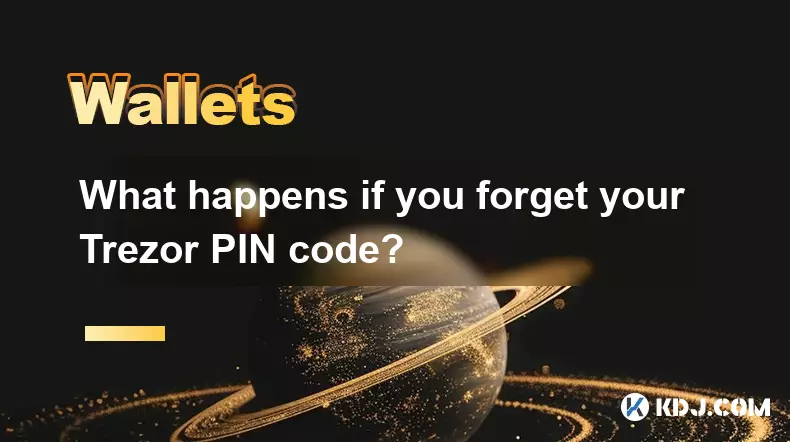-
 bitcoin
bitcoin $109547.008142 USD
0.04% -
 ethereum
ethereum $4011.838726 USD
-0.05% -
 tether
tether $1.000402 USD
-0.01% -
 xrp
xrp $2.798606 USD
0.88% -
 bnb
bnb $970.877944 USD
1.39% -
 solana
solana $202.237275 USD
-0.95% -
 usd-coin
usd-coin $0.999673 USD
0.00% -
 dogecoin
dogecoin $0.229294 USD
-1.15% -
 tron
tron $0.336370 USD
-0.45% -
 cardano
cardano $0.777260 USD
-1.66% -
 hyperliquid
hyperliquid $45.503019 USD
1.73% -
 ethena-usde
ethena-usde $1.000362 USD
0.01% -
 chainlink
chainlink $20.785303 USD
-1.10% -
 avalanche
avalanche $28.755822 USD
-0.11% -
 stellar
stellar $0.358303 USD
-0.48%
What happens if you forget your Trezor PIN code?
Forgetting your Trezor PIN locks you out permanently unless you have your recovery seed—without it, funds are irrecoverable after 16 failed attempts.
Sep 13, 2025 at 06:36 am

Understanding the Consequences of Forgetting Your Trezor PIN
1. The Trezor hardware wallet implements a robust security model designed to protect your cryptocurrency assets. When you set up the device, you are required to create a unique PIN code that acts as the primary layer of access control. This PIN is not stored externally and is known only to the user. If you forget this PIN, immediate access to your wallet becomes impossible.
2. Trezor devices feature a built-in mechanism to prevent brute-force attacks. After each incorrect PIN attempt, the device enforces an exponentially increasing delay before allowing another try. This means that after several failed attempts, the wait time could extend to hours or even days, discouraging unauthorized access while also making recovery through guessing practically unfeasible.
3. Unlike some software wallets, Trezor does not offer a 'forgot PIN' option or remote reset capability. There is no customer support channel that can recover or bypass your PIN. The system is intentionally decentralized and trustless, meaning no third party has the authority to restore access to your device once the PIN is lost.
4. The only reliable method to regain access to your funds after forgetting the PIN is through the use of your recovery seed phrase. This 12, 18, or 24-word sequence was generated during the initial setup and serves as the master key to your wallet. Without it, the funds are permanently locked.
5. If you enter the wrong PIN too many times, the device may trigger a self-wipe mechanism. Most Trezor models will erase all data—including the encrypted private keys—after 16 failed attempts. Once wiped, the device reverts to factory settings, and without the seed phrase, there is no way to restore the original wallet or its contents.
Recovering Access Using the Recovery Seed
1. To recover your wallet after forgetting the PIN, you must perform a seed phrase restoration on a new or reset Trezor device. Begin by initializing the device in recovery mode, which can be accessed through the Trezor Suite interface.
2. During the recovery process, you will be prompted to manually enter each word of your seed phrase in the correct order. The device verifies the integrity of the phrase using cryptographic checksums, so any mistake in spelling or sequence will result in failure.
3. Upon successful entry, the wallet regenerates all private keys associated with your accounts based on the deterministic algorithm defined by BIP-39 and BIP-44 standards. This ensures that all cryptocurrencies linked to the original wallet become accessible again.
4. It is critical that the recovery seed was written down accurately and stored securely. Digital copies, especially those saved online or in cloud storage, pose significant security risks and are strongly discouraged by Trezor’s official guidelines.
5. Once the recovery is complete, you can set a new PIN code. This step is mandatory and should involve selecting a number that is both memorable and resistant to physical observation (shoulder surfing).
Preventive Measures to Avoid Lockout
1. Users are strongly advised to write down their recovery seed on paper or use a metal backup solution designed for long-term durability. Storing it in a fireproof safe or secure deposit box adds an extra layer of protection.
2. Practicing PIN memorization through regular but cautious use helps reinforce memory without risking lockout. Avoid writing down the PIN itself under any circumstances, as this compromises the core security principle of the hardware wallet.
3. Keeping the recovery seed separate from the device prevents both items from being lost or stolen together. A common recommendation is to store backups in multiple secure locations, especially if large amounts of cryptocurrency are involved.
4. Periodically testing the recovery process with a small amount of cryptocurrency can verify that the seed phrase is correct and functional. This dry run should be conducted on a secondary device to avoid interfering with daily operations.
5. Never share your PIN or seed phrase with anyone, including support personnel claiming to represent Trezor. Legitimate service providers will never ask for these details.
Frequently Asked Questions
Can I reset my Trezor PIN without the recovery seed?No. Without the recovery seed, it is impossible to reset the PIN or regain access to the wallet after too many failed attempts. The device will erase itself, and no recovery method exists beyond the seed phrase.
Is there a way to change my Trezor PIN before I forget it?Yes. You can change your PIN at any time through the Trezor Suite dashboard while logged into your wallet. This allows you to update it to something more memorable while still in possession of current access.
What happens if I lose both my PIN and recovery seed?In this scenario, access to the funds is permanently lost. Cryptocurrency stored on the Trezor wallet cannot be recovered through any technical or customer support means. This underscores the importance of safeguarding both credentials independently.
Can someone else recover my wallet if they find my Trezor device?Only if they know the PIN or have access to the recovery seed. The device itself is useless without one of these components, ensuring that physical theft does not automatically lead to asset loss.
Disclaimer:info@kdj.com
The information provided is not trading advice. kdj.com does not assume any responsibility for any investments made based on the information provided in this article. Cryptocurrencies are highly volatile and it is highly recommended that you invest with caution after thorough research!
If you believe that the content used on this website infringes your copyright, please contact us immediately (info@kdj.com) and we will delete it promptly.
- Ethereum, Bitcoin Dominance, and the Altcoin Rally: A New York Minute on Crypto
- 2025-09-28 12:25:15
- RLUSD, XRP, and Open Interest: Decoding the Dynamics
- 2025-09-28 12:25:15
- Crypto Meme Coins: Unveiling the 2025 Potential
- 2025-09-28 12:25:16
- Crypto's Comeback: Solana, Polygon, and the Hunt for the Next Moonshot
- 2025-09-28 12:25:16
- Stablecoins, Financial Transactions, and the Future World: A New York State of Mind
- 2025-09-28 12:30:12
- XRP, Competitor, PDP Climb: Decoding the Crypto Landscape in 2025
- 2025-09-28 12:30:12
Related knowledge

How do I view smart contract interaction history in Coinbase Wallet?
Sep 24,2025 at 01:36am
Accessing Smart Contract Interaction History in Coinbase Wallet1. Open the Coinbase Wallet application on your mobile device and log in using your cre...

How do I use the token swap feature in Coinbase Wallet?
Sep 24,2025 at 05:00pm
Understanding Token Swaps in Coinbase Wallet1. The token swap feature in Coinbase Wallet enables users to exchange one cryptocurrency for another dire...

How do I participate in governance voting in Coinbase Wallet?
Sep 25,2025 at 01:55pm
Understanding Market Volatility in the Crypto Space1. Cryptocurrency markets are known for their extreme price fluctuations, often driven by sentiment...

How do I set up a custom RPC node in Coinbase Wallet?
Sep 24,2025 at 12:00pm
Understanding Custom RPC Nodes in Coinbase Wallet1. A custom RPC (Remote Procedure Call) node allows users to connect their Coinbase Wallet to a block...

How do I manage multiple assets in Coinbase Wallet?
Sep 23,2025 at 10:00am
Understanding Multi-Asset Support in Coinbase Wallet1. Coinbase Wallet allows users to store a wide variety of digital assets beyond just Bitcoin and ...

How do I connect Coinbase Wallet to a hardware wallet?
Sep 26,2025 at 02:54am
Connecting Coinbase Wallet to a Hardware Device1. Open the Coinbase Wallet app on your mobile device and ensure it is updated to the latest version. N...

How do I view smart contract interaction history in Coinbase Wallet?
Sep 24,2025 at 01:36am
Accessing Smart Contract Interaction History in Coinbase Wallet1. Open the Coinbase Wallet application on your mobile device and log in using your cre...

How do I use the token swap feature in Coinbase Wallet?
Sep 24,2025 at 05:00pm
Understanding Token Swaps in Coinbase Wallet1. The token swap feature in Coinbase Wallet enables users to exchange one cryptocurrency for another dire...

How do I participate in governance voting in Coinbase Wallet?
Sep 25,2025 at 01:55pm
Understanding Market Volatility in the Crypto Space1. Cryptocurrency markets are known for their extreme price fluctuations, often driven by sentiment...

How do I set up a custom RPC node in Coinbase Wallet?
Sep 24,2025 at 12:00pm
Understanding Custom RPC Nodes in Coinbase Wallet1. A custom RPC (Remote Procedure Call) node allows users to connect their Coinbase Wallet to a block...

How do I manage multiple assets in Coinbase Wallet?
Sep 23,2025 at 10:00am
Understanding Multi-Asset Support in Coinbase Wallet1. Coinbase Wallet allows users to store a wide variety of digital assets beyond just Bitcoin and ...

How do I connect Coinbase Wallet to a hardware wallet?
Sep 26,2025 at 02:54am
Connecting Coinbase Wallet to a Hardware Device1. Open the Coinbase Wallet app on your mobile device and ensure it is updated to the latest version. N...
See all articles










































































